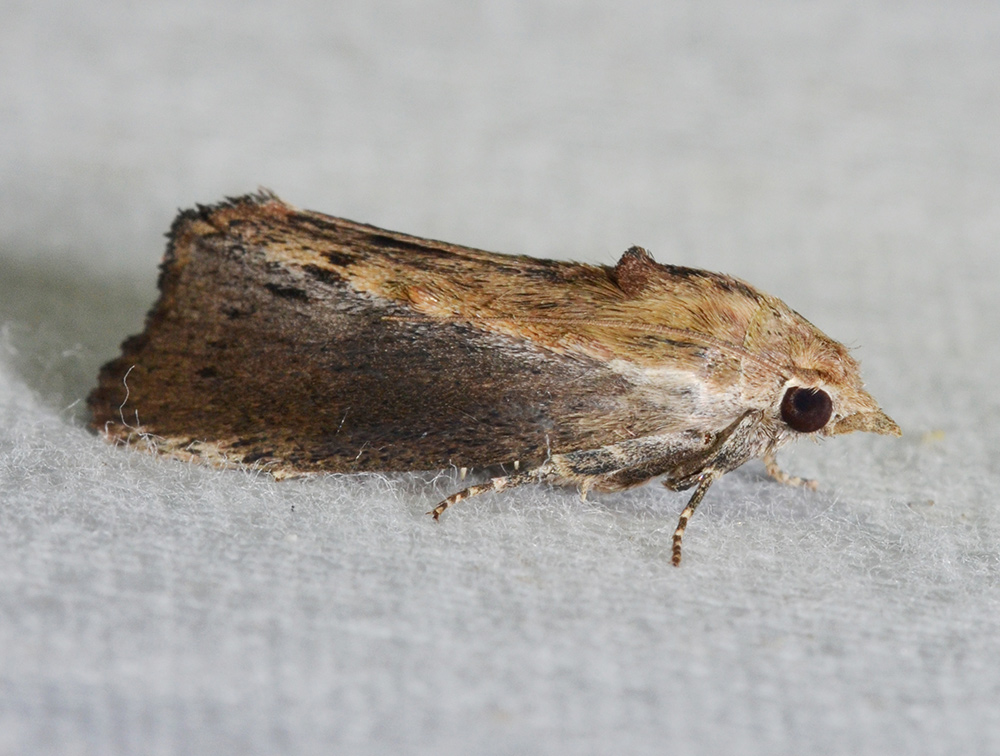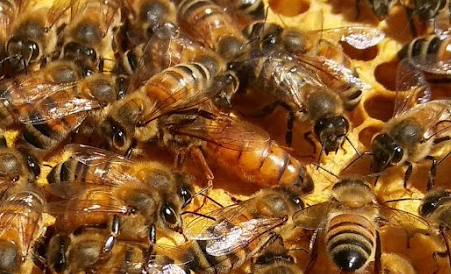I have talked about wax moths here before, but this is a more in depth focus on the biology of the pest so that we can better understand the problem we are all trying to deal with. Wax moth infestations cost the beekeeping industry millions of dollars each year in colony losses, equipment damage and time invested to clean up and rectify the issues. For that reason and the possible ability of vectoring pathogens, wax moth management is an often overlooked but important responsibility for beekeepers. In this article we will mainly talk about the Greater Wax Moth, Galleria mellonella , due to their greater distribution and level of damage and destruction.
LIFE STAGES AND LIFE CYCLE
EGGS
Adult female wax moths start laying eggs in dark crevices of a beehive almost immediately after mating. A single female will lay between 300 and 600 eggs in batches over the course of 3 – 5 days. Wax moth eggs are tiny, about 0.478 mm and 0.394 mm, length and width and can take between 3 and 35 days to hatch depending on the temperature.
LARVAE
When the larva hatches it is between 1 and 3 mm in length growing to between 25 and 30 mm before pupation. The wax moth larva is known as a polipod, with six legs on the thorax and many prolegs on the third to sixth abdominal segments. As soon as the larva hatches it begins burrowing through combs in the hive, lining the tunnels with a silk thread that can ultimately destroy the combs or frames for use by either the beekeeper or the bees. If a wax moth larvae tunnels through active brood comb it can result in bald brood (as the bees remove the cappings in response to the tunnel) or galleriasis can occur when emerging bees become entangled in the silk, ultimately dying of starvation.
The larvae will undergo between 8 and 10 moulting stages before pupation. The amount of time spent in the larval stage is, as is true with every other aspect of the GWM life cycle, variable depending on climatic conditions. The stage can last as little as 20 days or as long as 6 months. The optimal temperature for GWM development is between 84 and 91 degrees, making tropical and sub-tropical environments the areas of greatest proliferation.
PUPAE/COCOON
When the larva is ready for pupation it moves either to the wood of the frame or the box itself and chews a cavity in which it begins spinning the cocoon. Inside the cocoon the pupa morphs into an adult moth, the process taking between 3 days and 2 months, once again, depending on the temperature.
ADULT
After emerging from the cocoon the wax moth is on borrowed time. Due to their rudimentary proboscis, adult GWM’s do not eat at all and their only goal before death is to mate. Female wax moths live for 12 days while the males live longer, up to 21 days. At this stage of life the wax moth exhibits sexual dimorphism (distinct differences between sexes), the females are larger and darker than their male counterparts.
MATING
Male wax moths start to entice a female into mating by creating a sound from a tympanal organ; interested females respond by fanning their wings. After the initial greeting the male emits a pheromone that starts the mating process. As was stated earlier, the female begins oviposition (laying eggs) almost immediately after mating.
DISTRIBUTION
Greater and Lesser Wax Moths are found almost anywhere honeybees are located. The few areas of Asia and Africa that aren’t currently inhabited by the GWM are thought to be temporary vacancies as the environmental conditions change and the wax moths adapt and expand.
MANAGEMENT
The process of managing for wax moth deterrence and eradication should not be considered a solitary action. Integrated Pest Management practices are best here as the goals for the beekeeper are varied depending on whether you’re trying to be proactive or reactive and also on your local environmental conditions. What works for me here in Michigan will not directly relate to beekeepers in Texas or Florida and the methods of management are very different depending on whether you’re trying to avoid an infestation or clean up the damage already caused.
PROACTIVE DETERRENCE
The best deterrent to wax moths is an active, healthy and vigorous colony. The bees should only have as much space as they can effectively defend and that means removing extra or unnecessary boxes and dead outs from your apiary as soon as possible. Keep your colonies clean of debris, burr comb and areas that are difficult for the bees to access or defend.
Store your comb in areas that get light and have ample ventilation at least until winter (if it freezes regularly in your area) when you can move your boxes to a shed or barn until spring. If that is a problem for you, I have had success moving boxes into airtight lawn debris bags and sealing them with duct tape. Be sure to open those bags in the spring and get those combs in use in your apiary as this method is not perfect and any tiny opening in the bag can allow an adult to move in, where the bag will provide a perfect breeding environment.
Avoid chemical deterrents like mothballs and para-mothballs as the chemicals responsible for the deterring effect have been lableled as cancer causing by the State of California and direct access to the combs can contaminate the honey product. (Before you start to write me talking about the fleeting nature of paradichlorobenzene and how that makes it safe, ask yourself if you feel comfortable placing something the WHO labeled as “possibly carcinogenic” next to your honey product.)
REACTIVE REPAIR
While there are fumigants that can kill all stages of wax moth development, like carbon dioxide, that seems silly when a trip to the chill chest will solve the problem in a matter of hours. If your combs are not beyond repair, place them in a freezer for between 24 and 48 hours and then either store as directed or place into an active and healthy bee colony for repair and reuse.
THE IMPORTANCE OF PROPER WAX MOTH MANAGEMENT
The studies on the ability for wax moths to vector pathogens have indeed found viruses like Israeli acute paralysis virus and black queen cell virus in wax moth larvae and American Foulbrood spores in fecal pellets. Add to that the fact that improper management can create a regional outbreak much the same as expelling mite bombs into your neighboring apiaries and it becomes clear that the problem carries more weight than just the equipment damage or the frustration felt when you first discover a wax moth infestation. Stay on top of your equipment and check stored combs regularly to prevent a major outbreak in your beekeeping operation.
THE FUTURE OF WAX MOTH MANAGEMENT
Studies dealing with entomopathogens and baculoviruses as possible control agents are ongoing and may offer something useful in the future of wax moth pest management. Possible trapping scenarios using volatiles released from food sources and ovipositional sites may also offer some help in keeping regional wax moth populations in check. While these studies are interesting and may very well lead us to a system of management very different from what we’re used to, they are still in the discovery stages and are far from ready for public use. Until science brings us a better answer, the responsibility lies on us as beekeepers to keep infestations in check and maintain colonies with the ability to defend their hives from these problematic nocturnal invaders.
REFERENCES:
The Biology and Control of the Greater Wax Moth, Galleria mellonella – https://www.ncbi.nlm.nih.gov/pmc/articles/PMC5492075/
The Life Cycle Of The Wax Moth – http://www.dave-cushman.net/bee/waxmothlifecycle.html


